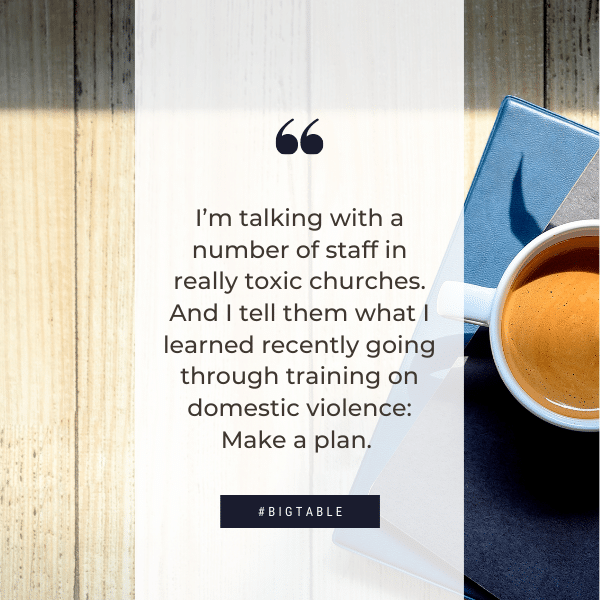So many great questions emerged during our LEAD WITH… Out Being an A$$hole webinar this past week! Some we had a few minutes to talk over then, others we just couldn’t get to… So we thought we’d take a shot at them by doing our FIRST. EVER. INSTAGRAM. LIVE. and then sharing the video with you all here, too.
Hooray for trying new things! Boo when they don’t work out quite as planned.
The IG Live was fun, but the video disappeared on us! So you get this little write-up instead.
1. “Is hierarchy always bad?”
Bill’s first answer – No. It’s fine to have a lead pastor in a church or an executive director in a nonprofit, and they clearly have authority.
Brenna – Yes. Or at least sub-optimally good. I think when someone like Bill says it’s ok to have hierarchy, what they’re really saying is that it’s ok to have structure, it’s ok to have clarity around roles and responsibilities, and to that, I say 100%.
But the word “hierarchy” carries with it not just the idea of being organized, but being organized in a top-down way. When I and many others use that word, we’re thinking about what Brené Brown calls “power over” systems, those that are essentially oppressive.
Why don’t we instead intentionally organize and get clear around roles and responsibilities in a mutual way, using “power with and for”?
Bill’s second answer – You’re right… [Brenna’s note: He doesn’t always let me win that easily.]
2. “Is it possible to defuse a toxic leader?” Or as another person put it, “How do you know when it’s time to cut your losses and let a system die?”
Brenna – Absolutely there are times we need to just go. Actually, our amazing friend, minister Riana Shaw Robinson is preaching at City Church LB this weekend, and I think her sermon, “It’s OK to Walk Away,” may really resonate if this is a question on your heart. (The recording should be up by Sunday evening.)
Is it possible for toxic leaders to change? Well, I think it’s a much-less-likely-to-change situation if you have a truly narcissistic leader at the helm, and sadly, there are plenty in “Christian” spaces.
But at least some leaders operating in damaging ways are just lacking skills; they’ve never been taught a better way. We are having some incredibly hope-inspiring conversations with some really seasoned leaders who are just inhaling it all, this new way of thinking about leading. Their hearts are wide open, and that makes all the difference.
Bill – Absolutely right. You can’t change a narcissist. In fact, you can’t change anyone else. What you can do is to change the leadership culture in the part of the organization you are responsible for.
And you can ask those who supervise you to consider new ways of handling authority. It’s particularly helpful if you have some resources you can lean on and talk through together, another model to refer to that has a track record of success and is available to learn. (Shameless promotion: this is what we cover in our LEAD WITH Teams cohort).
3. How do you survive in a toxic church?
Bill – I’m talking with a number of staff in really toxic churches. And I tell them what I learned recently going through training on how the church can better address domestic violence: Make a plan.
To pay the rent you may need to stay on for six more months, but there’s no reason you can’t start right now to make a plan. The first step in making a plan is building a team of people who you can absolutely trust. Process your pain with them and your ideas with them. And slowly take one small step after another… until you are out.
4. What do you do when you’re in a system that really wants you to be a dictator because it’s tired of being either empty or chaotic?
Brenna – Yes, this will absolutely happen. It’s what so many of our people have been trained to expect – the “benevolent dictator,” as one pastor regretfully described how he once understood his job description. We have to offer some counter-formation.
The sneakiest part though can be owning the role we may be playing in the situation. Lots of leaders I know over-function (yes, me too), and when we over-function, we’re basically telling the people around us we don’t need their contributions. But we do. And often it’ll be a joy for them, too, if we invite them to operate out of their gifts and passions and within healthy limits that we clearly, consistently honor.
So how much detail do I put onto the meeting agenda I’m creating v. leaving room for new ideas? And how many sections of the agenda do I lead v. suggesting someone else share their voice? How much of the community dinner do I prep, and how much do I invite people to chip in? Those kinds of questions matter.
5. How do you create healthy culture when you are just starting out leading an organization (and/or just starting the organization)?
Bill – The first step has got to be moving into self awareness. You’ve got to figure out who you are, how you lead, what your shadow side is, and what sorts of people you need on a team to complement you. So jump into therapy, do some Enneagram work, join a coaching cohort somewhere, and take a silent prayer retreat – do whatever you can to figure yourself out, everything from what baggage you’re bringing with you, to what settings call forth the best in you, to how you experience real renewal.
Brenna – It’s also going to be ideal to bring with you at least some thoughts (the more articulated the better) about how leadership works and the kind of leader you want to be. Like are you going to accept the common wisdom and set yourself up as the answer person in your organization? Or do you want to be a different kind of leader, be the question asking kind, the one who intentionally models and sets the table for vigorous, clarity-producing conversations where all the voices matter?
I guess it’s obvious which one I’d suggest!
That’s where we’ll wrap up today.
- Big thanks to all who came out for the webinar, including 1-2 amazing folks from our 21 Suggestions If We’re Not the Conversation Partners You Need list.
- And one last invitation to check out our LEAD WITH Teams course if these are the kinds of discussions you need space to dive into these days!



